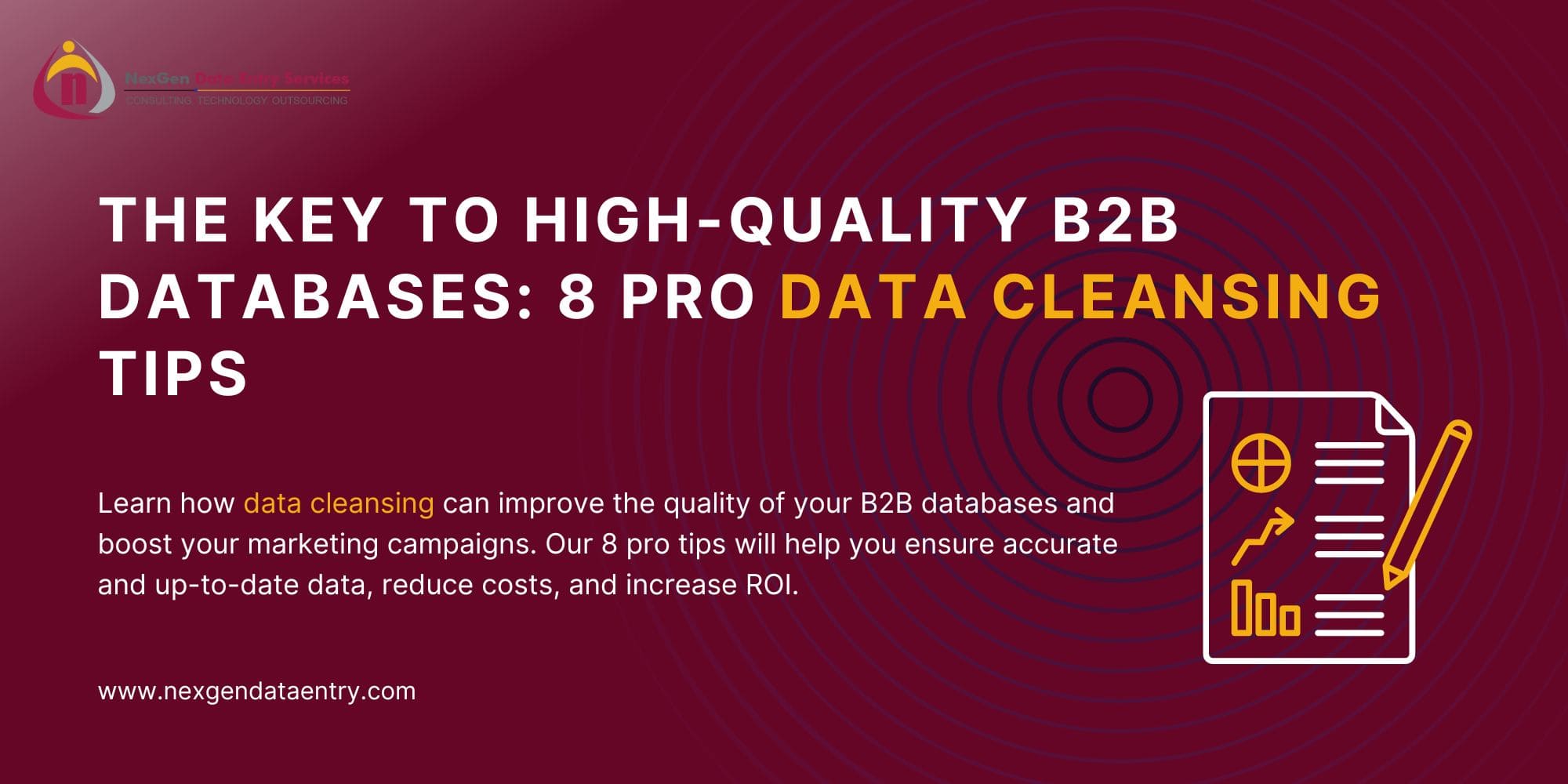 Data is the lifeblood of any successful B2B organization. A clean, high-quality database is essential for effective marketing campaigns, accurate sales forecasts, and informed decision-making. But how do you ensure your B2B database is up to snuff? The answer lies in data cleansing.
Data is the lifeblood of any successful B2B organization. A clean, high-quality database is essential for effective marketing campaigns, accurate sales forecasts, and informed decision-making. But how do you ensure your B2B database is up to snuff? The answer lies in data cleansing.
In this blog post, we’ll dive into the importance of data cleansing for B2B databases and share eight pro tips to help you maintain a high-quality database. Let’s get started!
What is Data Cleansing?
Data cleansing, also known as data cleaning or data scrubbing, is the process of identifying and correcting or removing errors, inconsistencies, and inaccuracies in datasets. This process ensures that your data is accurate, complete, and up-to-date, which is crucial for effective B2B marketing and sales efforts.
Why is Data Cleansing Important for B2B Databases?
A high-quality B2B database is essential for:
1. Targeted marketing campaigns
2. Accurate sales forecasts
3. Informed business decisions
4. Improved customer satisfaction
5. Compliance with data protection regulations
Now that we understand the importance of data cleansing, let’s dive into 8 pro tips for maintaining high-quality B2B databases.
1. Develop a Data Quality Plan
Before you start cleansing your data, you need a solid plan. A data quality plan outlines your objectives, the types of errors you’re looking to correct, and the steps you’ll take to achieve your goals. This plan will help guide your efforts and ensure you stay on track.
2. Standardize Your Data Entry Process
Inconsistent data entry is a leading cause of errors in B2B databases. Develop a standard data entry process and train your team to adhere to it. This includes using consistent formats for dates, phone numbers, and other data points, as well as implementing drop-down lists and other input controls to minimize manual data entry errors.
3. Validate Data at the Point of Entry
Catching errors at the point of entry is an effective way to maintain data quality. Implement real-time data validation techniques, such as email validation, to ensure the accuracy of data as it is entered into your system.
4. Use Automated Data Cleansing Tools
Automated data cleansing tools can save you time and effort by identifying and correcting errors in your database. There are numerous tools available, such as data quality software or AI-powered solutions, that can help streamline your data cleansing process.
5. Schedule Regular Data Audits
Regular data audits are essential for maintaining a high-quality B2B database. Schedule audits at least once per quarter to identify and correct errors, remove duplicates, and update outdated information.
6. Keep Your Data Up-to-Date
A high-quality B2B database is one that is up-to-date. Develop a process for updating your data regularly, such as through web scraping, APIs, or manual research. This ensures your marketing and sales teams are working with the most current information available.
7. Monitor Data Quality Metrics
Track key data quality metrics, such as accuracy, completeness, and consistency, to assess the health of your B2B database. Regularly monitoring these metrics will help you identify areas for improvement and ensure your data cleansing efforts are effective.
8. Foster a Data Quality Culture
Last but not least, foster a data quality culture within your organization. Encourage teamwork, accountability, and continuous improvement in data management. When everyone understands the importance of clean data, your B2B database will be more likely to stay in tip-top shape.
Here are some additional tips for cleaning data:
Ensuring high-quality data is crucial for accurate and high quality B2B database. In addition to the previous methods mentioned for improving data quality, there are other effective techniques that can be utilized:
- Use a data cleaning tool: A data cleaning tool is a specialized software that can help you clean your data more effectively and efficiently than using a spreadsheet. These tools can identify inconsistencies, missing values, and duplicates, and can help standardize data formats.
- Use a data dictionary: A data dictionary is a document that defines the data elements and attributes in a database. It provides a clear description of the data, including definitions, data types, and allowable values. By using a data dictionary, you can easily identify any errors or inconsistencies in your data.
- Use data profiling: Data profiling is the process of analyzing data to identify patterns and trends. It helps you to better understand the data and detect any errors or inconsistencies. For instance, data profiling can help you identify missing data, outliers, and invalid data.
- Use data validation: Data validation is the process of checking data for errors before it is entered into a database. This helps you to identify any errors in the data and correct them before they cause issues downstream. Data validation techniques include range checks, format checks, and consistency checks.
Conclusion
Cleaning data is a crucial task that can be challenging and time-consuming, but it is essential to ensure the accuracy and reliability of your data. To improve the quality of your data and make better decisions with it, you should use a variety of data cleaning techniques, such as filtering, formatting, and outlier detection. It’s important to be patient and persistent during the data cleaning process since it takes time to achieve the desired results. If you’re not comfortable cleaning data yourself, you can always hire a professional data cleansing services provider to help you identify errors and inconsistencies in your data. With clean and accurate data, you can make better decisions and improve your business outcomes.
